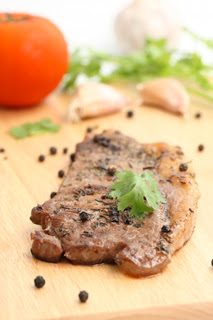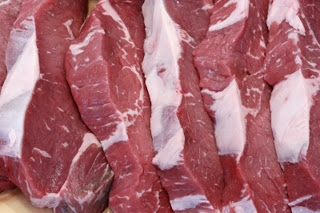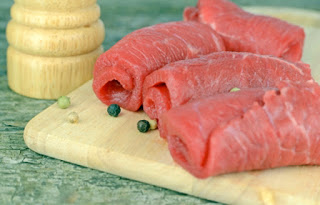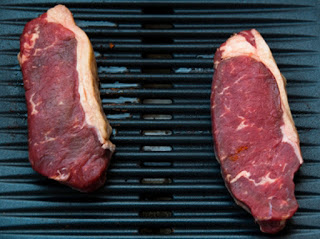For the second part of my grilling tips series, let’s talk about beef. I know there are other meats that are amazing on the grill–and I will touch on those, too, but we’ll start with the cow.
To begin, here are some terms you may have heard. Some you may be familiar with and some may be new to you. So if you already know all of this, bear with me as I clarify some basics for those that don’t.
1. Marbling: This refers to the fat that is webbed throughout the main body of the cut of beef; not the fat on the outside edges, but the veining lines running through the steak, loin, or other cut of beef. Marbling is synonymous with tenderness. It ensures a nice, juicy, tender piece of meat by contributing to the flavor and moistness as it cooks. Although the edge fat on meat will add some flavor, it’s the marbling in the cut of beef that really brings it all together. When buying beef, look for an outer layer of fat about 1/4 to 1/2 inch, and a good degree of marbling overall.
2. Grass Fed: This refers to a cow that has been fed nothing but grass for it’s entire life. Grass fed beef is said to have a more complex flavor and a sweeter aroma. Pure grass feeding of cattle is pretty common in other countries, but not in America. You may need to find a farm that offers this type of beef as a specialty. Happily, the request for grass fed beef is growing in America so keep your fingers crossed.
3. Organic Beef: In order for a piece of beef to be certified as organic, it has to meet certain qualifications. It must be fed 100% organic feed, it must never be fed hormones to promote growth, it is never given antibiotics, and it will be given access to pastures. Please note that grass fed beef does NOT guarantee a cut is organic. So look for the Organic labeling if you want to be sure it has been treated in an 100% organic way.
4. Grain Fed: This is the typical way American cattle is fed. It basically means the cow starts out grazing, but after a year, is moved to grain feed. It also means there may have been growth hormones and antibiotics used.
5. Meat Grading: All the meat sold in the USA is inspected for sanitary handling and overall safety for eating. As for grading though, it is usually reserved for the more luxurious cuts of beef. Most of the beef in America is what is called “No Roll”, which basically means it isn’t graded.
Now that you have a few terms under your belt, here is a list of the basic beef cuts. I have organized them from most tender to the toughest. I will try to include some of the best grilling techniques for each cut as well.
Short Loin: Cuts from this part of the cow are known as Tenderloin, Strip Steak, T-bone or Porterhouse. Look for nice marbling on these cuts. Best if cooked over direct heat, medium to medium-high.
Rib: Cuts from here include the Rib steak, Short ribs and Rib roast. These selections are best cooked over medium to medium-high heat. The Rib Steak is best over direct heat, while the Rib Roast and Short Ribs are best over indirect heat because they will need a longer cooking time.
Sirloin: Cuts from here are known by the names of Tri-tip, Sirloin Steak, and Bottom Sirloin. Bottom Sirloin and Sirloin Steaks are cooked best over direct medium-high heat. Bottom sirloin makes a great kebab. Tri-tip is best cooked over indirect medium-high heat. It takes well to marinades and is delicious on its own.
Plate: Also known as Hanger steak or Skirt steak. It’s best cooked over direct medium-high heat. This cut of beef is delightful used in fajitas. They are great marinated, too. Because they are usually a thin cut of beef they cook quickly.
Flank: Commonly called Flank steak it is delicious cooked over direct medium-high heat. Marinades well.
Round: Cuts from this portion are known as Top round, London Broil or Ground round beef. Top round is considered a tough cut and needs special treatment when grilling. Marinades can be used to tenderize them but they won’t do the whole job. They should be cooked over indirect heat low and slow. London Broils are tricky and need a lot of care. Marinade or brine for more tenderness, and although it can be cooked like any steak, it’s best to be sure and cut it properly to avoid long, stringy pieces.
Chuck: Cuts to look for in this category are Chuck Roast, Short Ribs, or Ground chuck beef. Chuck roasts or steaks should be cooked over indirect medium-low heat. Short Ribs should be cooked over indirect medium-high heat.
Brisket: In this case just look for a Brisket. Easy. The brisket is a hard cut of beef for the average cook. A brisket must be cooked low and slow over indirect heat. Basting is required or you will end up with beef jerky.
As far as telling when your meat is cooked, either use a meat thermometer, which I highly recommend, or you can use this basic guideline:
· Rare meat is very red and cool in the middle. The meat will feel jiggly when prodded with your tongs. Juices will be bloody.
· Medium rare is red with a warm center. Meat will still feel jiggly and juices will release from the meat still bloody.
· Medium is when the meat is pink in the center. It will feel a little more firm when prodded with tongs.
· Medium well is only slightly pink. It’s going to be more firm but, will still have some give. Juices will be more clear now.
· Well done is completely without pink. Meat will feel firm to the touch and the outside of the meat will be thoroughly cooked.
And last but, not least, it’s important to cut tougher cuts of meat against the grain. The grain is the direction the fibers run in the piece of meat. If you look at the picture below you can see that the veins of fat run side to side. That is the direction of the grain. To cut a tougher piece of meat you will want to cut opposite of the grain. So, again, on the picture below you would cut along the long side. Imagine a bunch of cables gathered together. If you cut with the grain you will be chewing that cable for a long time. If you cut against the grain you will be eating lovely, flavor filled little pieces that will melt on your tongue.
I hope this addition to my summer grilling tips series is helpful. In the next installment, we’ll cover chicken, fish, and pork. See you then.






Leave a Reply